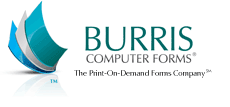Blank, Printable Recycled Postcards
by Raki Wright | Last Updated June 2, 2008In an effort to address the growing need for recycled products, Burris Computer Forms is pleased to announce an environmentally friendly addition to its Four-of-a-Kind Postcard™ line. This new product in the Burris line of blank, printable postcards is made from 30% recycled paper, which provides users the ability to print postcards in-house and still “go green.”
The postcards made from 30% recycled paper content are available on blank, white 8 ½ x 11 sheets perforated twice, for easy separating. This new product in its line of blank, printable postcards can be printed in-house on users’ own PCs, using laser or inkjet printers, or copiers.
The advantages of printing postcards in-house include fast turnaround, low cost, control of the project, and ability to print a few, or thousands, quickly and cost-effectively. Companies, churches, other non-profits, and individuals use Four-of-a-Kind Postcards™ as an easy, convenient, cost-effective way to deliver a message.
Website Paper Weight Equivalency Chart
by Raki Wright | Last Updated May 23, 2008Burris Computer Forms announces a new tool on its website which can be used to cross reference paper weights in gsm, bond, text/book, cover, bristol, index, and tag.
The paper weight equivalency chart references the terminology a user may be more familiar with in their industry. Oftentimes paper manufacturers specify their papers’ weights in different measurements. With Burris’ new paper weight equivalency tool, users can easily find what papers their printer will handle, regardless of the way the weight is expressed.
The chart compares different paper weights to gsm or g/m2, grams per square meter — the metric measure of the density of paper, a measure often quote by printer manufacturers. Other paper measurements depend on the basis size from which to calculate its variable weight, which requires background knowledge of what size paper is used in each scenario.
A widget (a downloadable interactive tool) is available for use on any website or desktop.
What Paper Will My Printer Handle? Website Tool
by Raki Wright | Last Updated May 16, 2008
A new chart is also available to help users compare paper weights. A widget (a downloadable interactive tool) is available for use on any website or desktop.
New “Find your paper” tool
by Raki Wright | Last Updated July 20, 2007In our last post, we told you about ways to find out more information about your printer. For more help, use the “Find Your Paper” tool at https://pcforms.com/printer_specs.php.
How do I know which papers will work in my printer?
by Raki Wright | Last Updated July 13, 2007Printer manufacturers generally offer both User’s guides and specification sheets. The User’s Guide will explain how to use the printer in a detailed manner. The specification sheet will list features such as memory capacity, print speed, paper tray capacity, paper types supported, tray use, print quality, and other printing characteristics. If you cannot find the User’s Guide that was supplied with your printer, use your favorite search engine to find your printer manufacturer’s website. Then, look for a product support link. Type in your printer’s model number and you will likely find a User’s Guide in .pdf format. If this is unsuccessful, type the printer’s make and model into the search engine to search for a guide posted elsewhere. You may also find information about successes and problems that other users have had with a particular printer.
There are also many websites, discussion boards, and blogs which feature printer reviews, feedback, and tips. A few great resources include www.pcmag.com, www.cnet.com, and www.pcworld.com . Once you are equipped with knowledge about your printer and its particulars, you can begin to use your printer to its fullest capabilities. If you have any problems, consult the troubleshooting section in the User’s Guide or on the manufacturer’s website. Happy printing!
